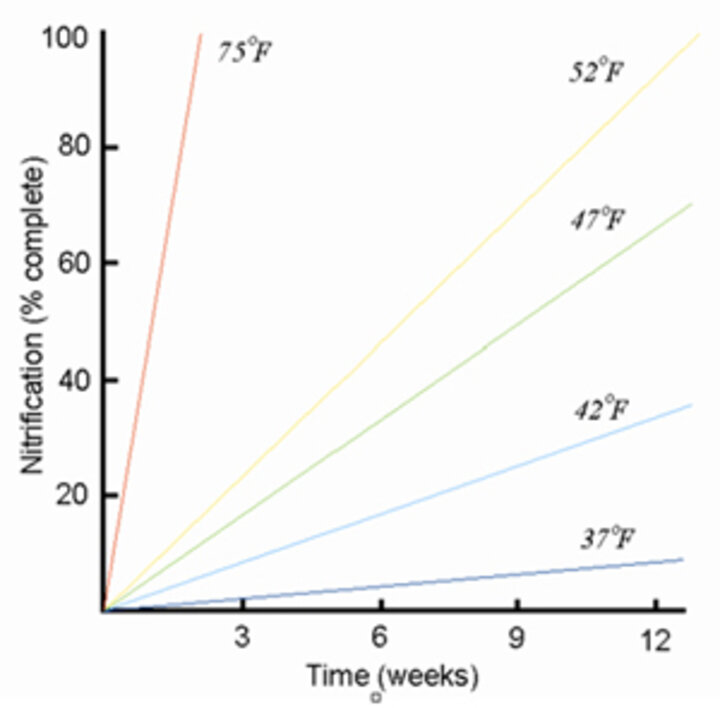May 25, 2007
Significant rainfall in parts of Nebraska over the past three weeks has many producers wondering how much of the nitrogen (N) fertilizer they applied is still available to the crop. Several factors can influence the amount of N loss, including rainfall amount and intensity, soil texture, soil temperature, fertilizer source and application date. Loss pathways can include runoff, ammonia volatilization, denitrification and leaching.
Runoff
If fertilizer had been recently applied to the soil surface, without incorporation or gentle rain of 1/2 inch or more to move N into the soil profile, substantial N loss may occur in runoff associated with intense rainfall.
Ammonia Volatilization
Nitrogen supplied from urea-based fertilizer (urea or urea-ammonium nitrate solution [UAN]) can be lost as ammonia gas to the atmosphere under certain conditions. The greatest risk is from fertilizer broadcast to warm, moist soils with heavy residue. Rainfall of 1/2 inch or more generally is adequate to move fertilizer into the soil and protect it from ammonia volatilization. Very light rains, of 1/4 inch or less, may only moisten the residue and soil, increasing loss rather than preventing it. One useful tool to estimate nitrogen loss potential due to ammonia volatilization is a software calculator available for free download from Agrotain at http://www.agrotain.com/usa/agricultural/calc.html
Denitrification
The primary N loss mechanism from saturated, fine-textured soils is likely denitrification. This is the process which converts nitrate-N into gaseous forms (nitric oxide, nitrous oxide, dinitrogen) using anaerobic bacteria present in the soil. These gaseous forms of nitrogen can be lost to the atmosphere. In fields where the majority of fertilizer N was applied before planting, likely four to eight weeks ago, much of the N may have been converted to nitrate by the microbial process of nitrification. This nitrate is then susceptible to loss via denitrification or leaching.
Leaching
If nitrogen existed in soil in the nitrate or urea forms, significant leaching loss can occur with heavy rains, more so on coarse-textured soils. Some of this N may have leached deep enough into the root zone to be unavailable to the crop, at least early in the season. Continued precipitation or irrigation may leach this N out of the root zone entirely.
For more information on soil processes influencing N management, see UNL Extension's Nutrient Management for Agronomic Crops, EC-155.

|
| Figure 1. Estimated nitrification over time. |
Management Options
Unfortunately, there are many variables interacting to influence the potential for N loss, making it difficult to estimate how much fertilizer N has been lost and to determine whether producers should apply more fertilizer. Research in Iowa suggests approximately 4%-5% of nitrate-N can be lost via denitrification for each day soils are saturated. Figure 1 can be used to estimate the rate of conversion from ammonium to nitrate following anhydrous ammonia application. For anhydrous ammonia applied six weeks ago, perhaps at least 50% of the N has been converted to nitrate. If soils were saturated for five days, as much as 10-12% of applied N may have been lost to denitrification, with additional potential loss due to runoff or leaching. Whether remaining N will be adequate to optimize yield potential depends on the initial application rate and growing conditions during the rest of the season.
Soil sampling is one option to evaluate how much nitrogen remains available. The pre-sidedress nitrate test (PSNT) is used to evaluate N availability resulting from fertilizer residual nitrate-N and early season N mineralization from soil organic matter (Iowa State University publication PM 1714). Beginning when corn plants are 6-12 inches tall, collect soil samples to a depth of one foot, compositing at least 12-15 cores from the area of interest into one sample. If fertilizer has been banded, more samples will be necessary and results may be less reliable. The test will not detect residual ammonium-N from fertilizer and may underestimate the amount of fertilizer N remaining. If the PSNT finds 25 ppm or more nitrate-N in the top foot of soil, no additional fertilizer is needed. If the PSNT is 16-25 ppm, apply an additional 30 lb N/acre, if 11-15 ppm, apply an additional 60 lb N/acre, and if less than 11 ppm, apply an additional 90 lb N/acre.
Carefully monitoring the crop for N status is another option, primarily between now and silking, especially if producers have the option to sidedress, fertigate or apply N with high clearance equipment. Most corn hybrids will take up most of their N in this period. Visual observation for signs of N deficiency (lower leaves yellowing, inverted V yellowing pattern of leaf tips) is one option, although yield potential may be reduced by the time N deficiency is visually evident.
A chlorophyll meter may be useful in detecting N stress before it can be seen. To calibrate chlorophyll meter readings, it is best to have one or more strips in the field with N applied at a rate high enough to be non-yield limiting to serve as a reference. For more information see Using a Chlorophyll Meter to Iprove N Management (NebGuide 1632).
Richard Ferguson
Charles Wortmann
Charles Shapiro
Extension Soils Specialists
